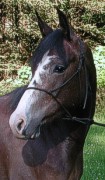|
12/12/04
Maverick #4
Maverick's progress for the 2004 riding
year was impressive. I started him in March and rode him consistently
through September. Interspersed were layoffs of 2 to 3 weeks.
Layoffs are not always necessary. However, they can be beneficial
to horses of all ages especially young ones as it gives them
an opportunity to relax and absorb their new lifestyle. Predictably,
Maverick was better after each layoff. In the fall, his progress
seemed to reach a plateau so I replaced the ring snaffle bit
with a shank snaffle.
The first ride using the shank snaffle was as I expected. He
took the bit when bridled as he had with the ring snaffle. I
mounted and sat in the neutral position. He stood still and waited
for a cue. Using slow hands, I took the slack from the reins
to let him know and feel there was something new which was the
curb strap that would produce a new feel. I did not want to surprise
him with the grab from the curb strap, consequently I adjusted
it loosely, as is my normal practice. The technique allowed him
to respond to the slack being removed from the reins before he
felt the contact from the curb strap. This was part of preparing
him for a signal bit.
Maverick showed no confusion between the shank and ring snaffle
bits because pressure was offered slowly, softly and without
sharp contact. My only aim for his first ride using the shank
snaffle was to just go the distance. During the ride I
would offer a suggestion, a feel here, or a pull there. I wanted
to give him time to become comfortable with the timing between
the rein movement and the curb strap contact.
The second ride was impressive. I followed the same saddling
routine as always. I then offered him the bit and allowed him
to take it rather than me putting it into his mouth.
The common practice is for the rider to place his thumb in the
corner of the horse's mouth in order to put the bit into
the horse's mouth. Do you recognize a difference between the
two methods?
When Maverick was saddled and ready to be ridden, I mounted and
sat in the neutral position. Then came the surprise. I slowly
began to remove slack from the reins and as soon as he felt them
move, he immediately bridled. His head was vertical and
I never felt any contact with his face. He waited in this formal
position for a cue from me. What do you think I did? Yes
! I waited a few moments and released. His
response was the correct answer to rein movement, so the
release was his reward. It was as though he had thought about
it all night and figured it out. I am still excited because this
told me I had done a good job preparing him for a position of
transition. Keep It Simple. I have continued to ride him
cross reined and one handed. If I need to use two hands, I can.
He seems ready to advance in his preparation toward becoming
a finished horse.
Maverick is riding better early in the shank snaffle than I would
have guessed. He does experience "hard spots" which
is normal, but all of his rides have been positive. The "hard
spots" have been addressed by "increasing the volume"
not by overpowering or intimidation. Less is More. On
a few occasions it has been necessary to "keep the promise."
Consistency and careful choosing of when and how
I send a signal have built his confidence and ability to give
the correct answer.
My goal is to ride Maverick in a signal bit which has a high
ported mouth piece such as a spade bit. The following is the
sequence that takes place when using a signal bit. First, there
is rein movement followed by the top of the spoon contacting
the roof of the mouth, "the signal". Next is curb strap
contact. Finally, the mouthpiece bar exerts downward pressure
on the tongue. Look at all the get ready signals before
the final promise of tongue pressure. When Maverick becomes comfortable
and responsive with the shank snaffle, a signal bit will be introduced.
There will be a transition bit between the snaffle bit
mouthpiece and the spade bit. That transition will have a California
Pleasure Horse mouthpiece probably without a roller. I doubt
he will use a roller because he is relatively relaxed. I will
however, make sure I do not leave him in the shank snaffle too
long. Horses tend to become dead in the mouth with the snaffle
which takes their brightness away. Since I have not used a hackamore
on him, I will not use the traditional California Two Rein method.
I am not in a hurry therefore I have confidence he will do well
in the higher ported bit.
Maverick's overall evaluation is a strong "A."
His attitude and self confidence are exceptional. I plan to ride
him during the winter as good weather and opportunity permit.
Maverick is an outstanding prospect irregardless of his breed.
He is just a nice horse.
Keep It Simple.
|


